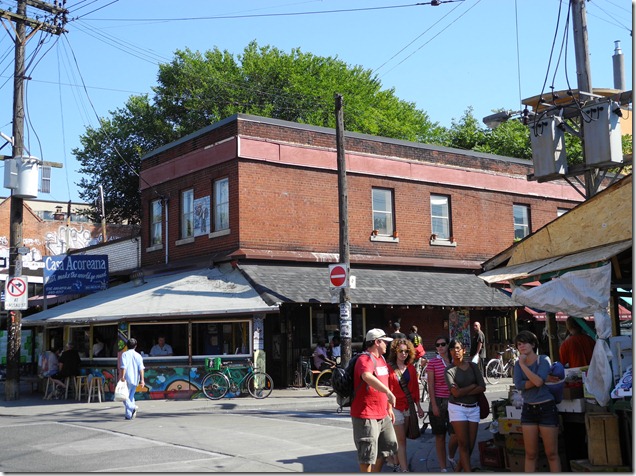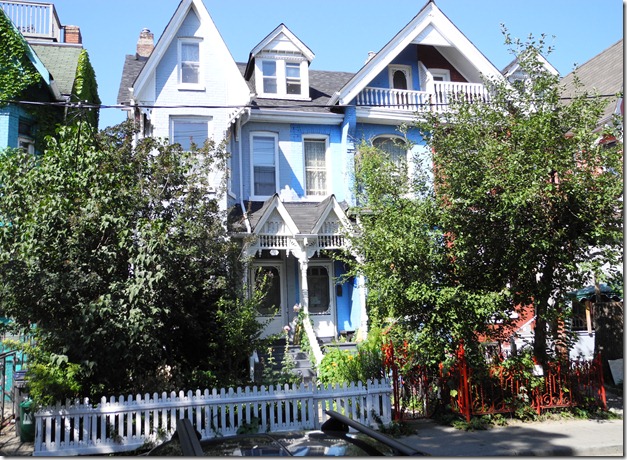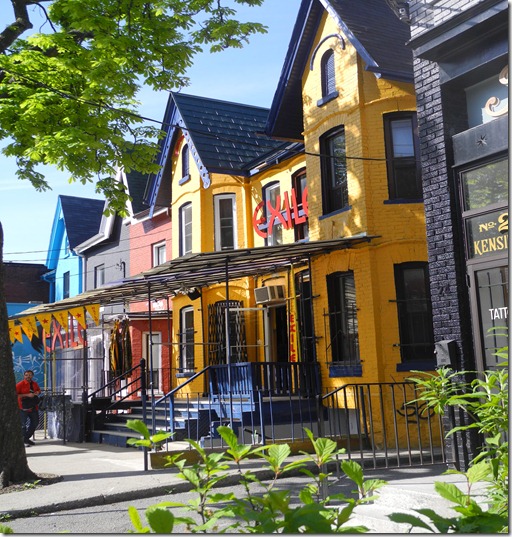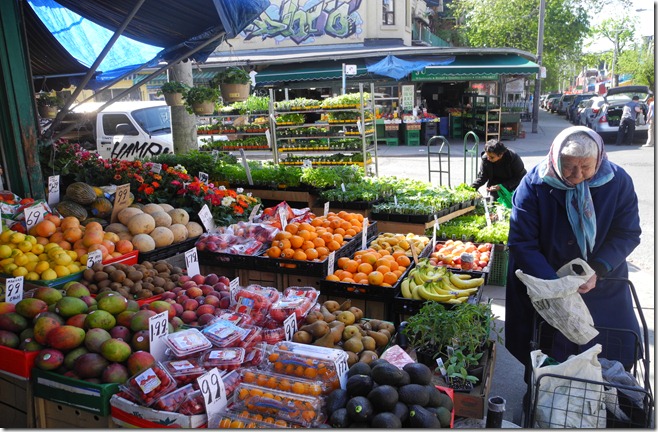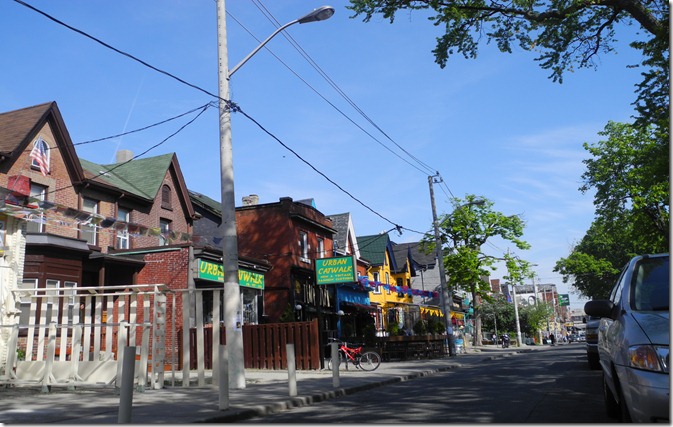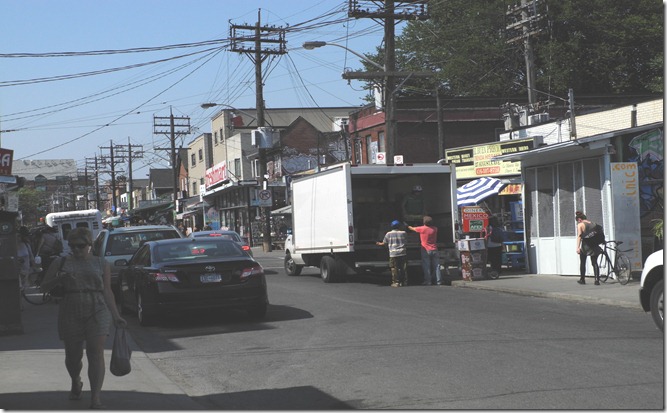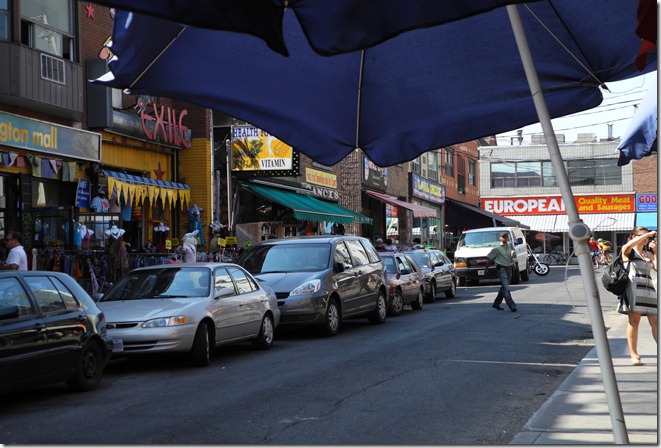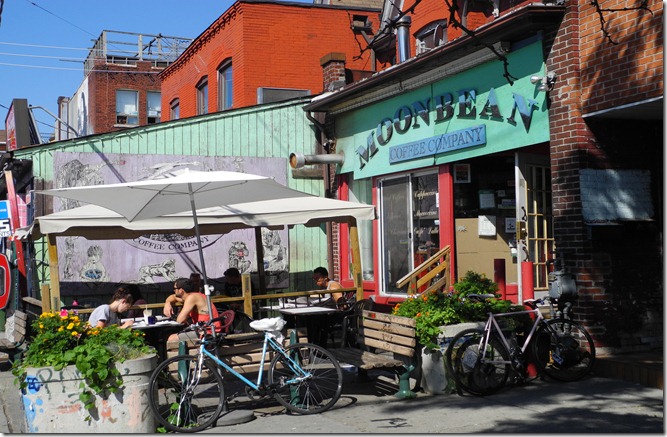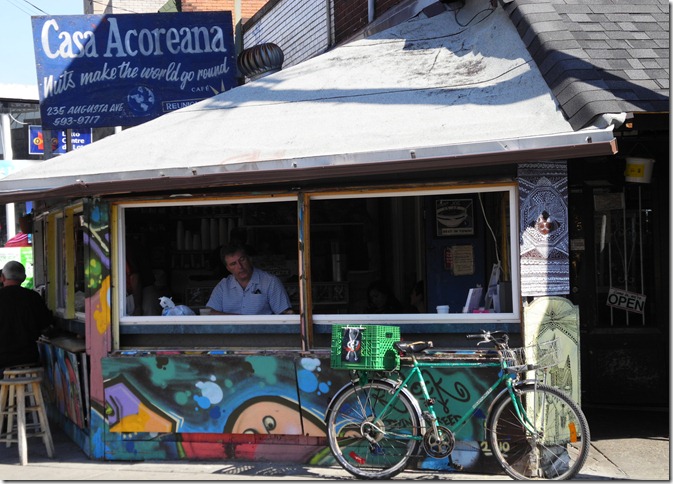Casa Acoreana Cafe and Food Shop on the corner of Baldwin and Augusta, on a summer day in 2012
This post was inspired by the article on the front page in the GTA Section of today’s (March 6, 2013) Toronto Star. A member of the Star Staff, who was was not identified, wrote about the rent increases in the Kensington Market that will force some of the shops to close. The cost of renting space will be affordable only by the large chain stores, most of them American owned. If the present trend continues. Toronto will lose one of the most unique neighbourhoods in the city. A few years ago, it was voted as being the best neighbourhood in North America. Though some may debate the merits of this award, most people agree that is one of the most unusual and diverse areas in our city. Its loss will be tragic.
The article in the Star centred around an interview with Ossie Pavao, who operates the shop known as Casa Acoreana Cafe and Food Shop at the northeast corner of Baldwin and Augusta Streets. I buy my spices and herbs at this shop. Because I can purchase small amounts, I am able to replace the spices frequently, before they lose their flavour. There are other aspects of Casa Acorena that I enjoy. When I gaze up at the large jars of candy on the upper shelves, I recall my days as a child gazing at the penny-candy in the window of my local variety store. The friendly, knowledgeable service I receive at Casa Acoreana is also an attraction.
However, the total rent for for building in which Pavao operates his business, along with several other merchants, is soon to be $10,000 per month. This will force the present renters from the premises. I will truly feel the loss. I shop at the Kensington Market three or four times a week. I know many of the merchants, and though they do not know my name, they recognize me. I usually shop early in the morning on weekdays, so they are not as busy as later in the day. They have time to chat and joke about life’s daily activities and problems. From the conversations that I overhear around me in the Market, I have become truly aware that it is a village surrounded by the larger Toronto scene.
I add my lament for the demise of the unique shops of Kensington. However, I will centre this post upon the architecture of the area. When I first started to study the buildings that line its streets, I was fascinated by how the architecture has evolved.
During the 19th century, the area that is today known as Kensington Market was home to working class immigrants, mostly from the British Isles. However, during the second decade of the twentieth century, Anglos were moving out of the district, seeking larger and newer residences further to the west, on streets such as Palmerston and Euclid. Kensington was close to the garment shops on Spadina, where many of the Jewish immigrants had found employment. The small homes in the Kensington area, built on narrow streets, were inexpensive to purchase. Extensions could easily be added to the rear of the houses. Single-family homes were often subdivided to provide space for several families, thus providing more assistance with the mortgage.
For many immigrants, the first method of starting a business was to sell goods from a knapsack on their back, and walk the streets to reach the customers. As soon as possible, a push-cart was acquired, allowing larger amounts of merchandise to be carried. Many chose the “rag trade,” as being low in prestige, there was not much competition. Some gathered bottles, cleaned them, and resold them to factories. Others collected old sewing machines, repaired them, and resold them. They collected anything of value that was available, and disposed of it for whatever price they could obtain. Others sold fruit and vegetable from their carts. All these enterprises required almost no capital to commence, and allowed the vendors to be free to worship on the Sabbath.
When funds were available, stalls were built across the front of some of the small Kensington homes. Others opened stores in the front rooms of the houses. While the men pushed their carts through the streets, in weather that was often inclement, the women sold goods from these make-shift shops to earn extra income for the family.
Eventually modest extensions were constructed on the front of the homes, replacing the stalls, and temporary shops. The Kensington Market was born. Merchants and their families lived above the stores or behind them. The district was slowly transformed from a quiet residential community into a vibrant shopping area with a European “shtetle” atmosphere. Despite its similarity to Jewish areas in other cities, such as the Lower East Side in New York, or London’s Whitechapel, Kensington was a unique creation, “one of a kind.”
Today, many Victorian homes remain behind the commercial storefronts. Gazing upward, many of the peaked roofs and ornate trim of the old houses remain, though many have been severely altered. Augusta Avenue, Baldwin Street, St. Andrew’s Avenue, and Kensington Avenue all contain examples of storefronts that extend from the houses to the edge of the sidewalks, where at one time the lawns were located.
Today, the Jewish market has mostly disappeared, and the small shops of yesteryear have become ethnic stores—West Indian, Latino, Caribbean, East Indian, and Portuguese.
The above information is from the book entitled “The Villages Within”—a study of the Kensington Market, Queen Street West, and the Kings West.
For a link to this book: https://tayloronhistory.com/the-villages-within/
During the 19th century, homes in the Market area were mostly Victorian Bay-and-Gable houses, such as these that remain on Kensington Avenue.
Many of the old Victorian homes on Kensington Avenue have now been converted shops. Their facades are lavished with bright colours that add charm to the street, creating an avenue that is fascinating to stroll. It was houses such as these that the Jewish merchants placed stalls in front of, on the lawns, and then, began selling goods.
The custom of street-stalls has not disappeared from the modern Kensington scene. This display surrounds a Victorian house on two sides. Across the street can be seen more outdoor stalls surrounding a 19th-century dwelling.
Eventually, some of the stalls were replaced with additions built across the front of the houses. In this view, looking north on Kensington Avenue toward Baldwin Street, the old houses are visible. Many have extensions built across them that sell various goods.
Examining the tops of the buildings, the original 19th-century structures remain visible. In some instances, the homes have been butchered, with peaked pediments removed and boxy structures constructed over them.
This section of Kensington Avenue has a few original buildings, with additions added to them, while others are more modern structures that were built to replace those that were destroyed by fire.
The Moonbean Cafe on St. Andrew’s Street has an addition that has been built onto a house constructed in the 1870s. It is one of the oldest structures in the Market.
These shops on Baldwin Street are contained in small additions that were added to the front of small labourers homes from the 19th century. The small home can easily be seen behind the store that contains the “Coral Sea Fish Market.”
In all seasons of the year, Kensington is a magical place. I hope that Casa Acoreana never disappears from the scene.
To view the Home Page for this blog: https://tayloronhistory.com/
To view other posts about the history of Toronto and its buildings:
St. Stanislaus Koska RC Church on Denison Avenue
The Bishop’s (St, Michael’s) Palace on Church Street, Toronto
https://tayloronhistory.com/2013/03/02/torontos-architectural-gemsbishops-palace-on-church-street/
The Ed Mirvish (Pantages, Imperial, Canon) Theatre, a true architectural gem on Toronto’s Yonge Street
The Waverly Hotel on Spadina near College Street.
https://tayloronhistory.com/2013/02/16/toronto-architectural-gemsthe-waverly-hotel-484-spadina/
The Art Deco Bank of Commerce building on King Street West.
The Postal Delivery Building, now the Air Canada Centre (ACC)
The Bellevue Fire Station on College Street
https://tayloronhistory.com/2013/02/14/torontos-architectural-gems-bellevue-fire-station/
The Bank of Nova Scotia at King and Bay Streets
Toronto’s old Sunnyside Beach
https://tayloronhistory.com/2013/02/01/a-pictorial-journey-to-sunnyside-beach-of-old-part-one/
https://tayloronhistory.com/2013/02/03/a-pictorial-journey-to-torontos-old-sunnyside-beach-part-two/
Toronto’s architectural gems—the Runnymede Library
https://tayloronhistory.com/2013/02/05/torontos-architectural-gems-runnymede-library/
Spadina Avenue – sinful, spicy and diverse
https://tayloronhistory.com/2012/09/28/sinfully-saucy-and-diversetorontos-spadina-avenue/
The Reading Building, a warehouse loft on Spadina Avenue
https://tayloronhistory.com/2013/01/20/torontos-architectural-gemsthe-reading-building-on-spadina/
The Darling Building on Spadina Avenue
https://tayloronhistory.com/2013/01/19/torontos-architectural-gemsthe-darling-building-on-spadina/
The amazing Fashion Building on Spadina Avenue
Toronto’s architectural gems – the Tower Building at Spadina and Adelaide Street
The Balfour Building at 119 Spadina Avenue
The Robertson Building at 215 Spadina that houses the Dark Horse Espresso Bar
An architectural gem – Grossman’s Tavern at Spadina and Cecil Streets
https://tayloronhistory.com/2012/11/08/architectural-gem-grossmans-tavern-at-377-9-spadina/Historic
History of the house that contains the Paul Magder Fur Shop at 202 Spadina
An important historic building that disappeared from the northeast corner of Spadina and College
Historic bank building on northeast corner of Spadina and Queen West
https://tayloronhistory.com/2012/12/02/torontos-architectural-gemsbank-at-spadina-and-queen-west/
History of the Backpackers’ Hotel at King and Spadina
https://tayloronhistory.com/2012/03/31/history-of-the-backpackers-hotel-at-king-and-spadina/
Hamburger corner – Spadina and Queen Streets
https://tayloronhistory.com/2012/10/10/torontos-hamburger-cornerwhere-is-it-and-why/
Lord Lansdowne Public School on Spadina Crescent
The Victory Burlesque Theatre at Dundas and Spadina
https://tayloronhistory.com/2012/09/08/the-sinful-victory-burlesque-theatre-at-dundas-and-spadina/
The Dragon City Mall on the southwest corner of Dundas and Spadina
https://tayloronhistory.com/2012/08/25/torontos-heritage-the-southwest-corner-of-queen-and-spadina/
Buildings on the west side of Spadina a short distance north of Queen Street.
History of the site of the Mcdonalds on northwest corner of Queen and Spadina
https://tayloronhistory.com/2012/08/27/mcdonalds-at-queen-and-spadina-on-an-historic-site/
A former mansion at 235 Spadina that is now almost hidden from view.
ttps://tayloronhistory.wordpress.com/2012/07/04/torontos-architectural-gems-is-this-one-a-joke/
Military hero of the War of 1812 lived near corner of Spadina and Queen West.
To view other posts about Toronto’s past and its historic buildings:
The Art Deco bus terminal at Bay and Dundas Streets.
Photos of the surroundings of the CN Tower and and the St. Lawrence Market in 1977
The old Dominion Bank Building at King and Yonge Street
The Canada Life Building on University and Queen Street West.
Campbell House at the corner of Queen Street West and University Avenue
A study of Osgoode Hall
https://tayloronhistory.com/2012/04/12/enjoying-torontos-architectural-gems-osgoode-hall/
Toronto’s first City Hall, now a part of the St. Lawrence Market
Toronto’s Draper Street, a time-tunnel into the 19th century
The Black Bull Tavern at Queen and Soho Streets, established in 1822
History of the 1867 fence around Osgoode Hall on Queen Street West at York Street
Gathering around the radio as a child in the 1940s
The opening of the University Theatre on Bloor Street, west of Bay St.
https://tayloronhistory.com/2012/02/24/the-opening-of-torontos-university-theatre-on-bloor-street/
122 persons perish in the Noronic Disaster on Toronto’s waterfront in 1949
Historic Victoria Memorial Square where Toronto’s first cemetery was located, now hidden amid the Entertainment District
https://tayloronhistory.com/2012/01/09/victoria-square-in-torontos-entertainment-district-is-a-gem/
Visiting one of Toronto’s best preserved 19th-century streets-Willcocks Avenue
The 1930s Water Maintenance Building on Brant Street, north of St. Andrew’s Park
Toronto’s architectural gems-photos of the Old City from a book published by the city in 1912
Toronto’s architectural gems in 1912
https://tayloronhistory.com/2012/12/04/torontos-architectural-gems-in-1912/
Toronto’s architectural gems – the bank on the northeast corner of Queen West and Spadina
https://tayloronhistory.com/2012/12/02/torontos-architectural-gemsbank-at-spadina-and-queen-west/
Photos of the surroundings of the CN Tower and and the St. Lawrence Market in 1977
The St. Lawrence Hall on King Street
https://tayloronhistory.com/2012/04/28/enjoying-torontos-architectural-gems-the-st-lawrence-hall/
Toronto’s streetcars through the past decades
https://tayloronhistory.com/2012/03/26/memories-of-torontos-streetcars-of-yesteryear/
History of Trinity Bellwoods Park
https://tayloronhistory.com/2012/04/09/the-history-and-beauty-of-trinity-bellwood-park/
A history of Toronto’s famous ferry boats to the Toronto Islands
Toronto’s Old City Hall at Bay and Queen Streets
https://tayloronhistory.com/2012/04/22/enjoying-torontos-architectural-gems-old-city-hall/
